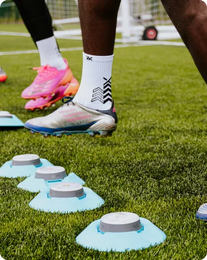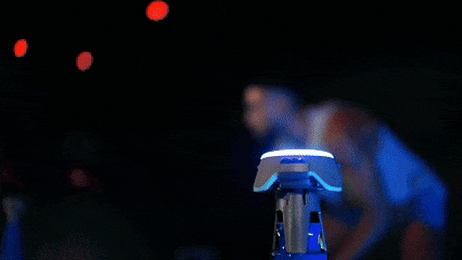It's a common question when we marvel at an athlete's quick dodge or when we instinctively pull our hand away from something hot. Reflexes are fascinating but often misunderstood aspects of our biology. Athletic champions seem to move faster than thought, leading many to wonder: Can we train our reflexes to become faster, more agile, and more precise?
Let’s dive into what reflexes actually are, why they are important and what the difference is between them and reaction time.

What Exactly Is a Reflex?
Before we can understand how to train reflexes, we first need to clarify what a reflex actually is. Simply put, a reflex is an involuntary, almost instantaneous movement in response to a specific occurrence.
It’s a rapid, automatic response that doesn’t require conscious thought; like jerking your hand away from a hot stove or blinking when something flies toward your eyes. Reflexes are built into our nervous system to protect us by helping us react quickly to danger.

When we ask, “How does a reflex work?” it’s about how your body reacts quickly to something, like touching something hot. Your body senses the danger and instantly sends a message through your motor neurons to the muscles in your hand to pull away, without needing to think about it. This all happens in a split second, allowing you to react almost instantly and move instinctively.
The Common Misconception: Reflexes vs. Reactive Intelligence
Now that we understand the basic function of how a reflex works, it's essential to clear up a common misconception: the idea that reflexes can be trained. This is where the confusion often comes from.
People frequently believe that by repetitively practicing the same movements, they can improve their reflexes. However, the reality is a bit more complex.
While it’s true that repetitive practice can make certain movements feel automatic, what you’re really training isn’t the reflex itself, but your Reactive Intelligence.

This term refers to your brain’s ability to process, recognize, and respond to different scenarios with speed and precision. Unlike reflexes, which are innate and fixed, Reactive Intelligence is adaptable and can be improved through training.
Think of it this way: when you first learned to drive, your reflexes - like slamming on the brakes when you see an obstacle on the road - were essential. But as you gained experience, your brain started to anticipate different driving scenarios, allowing you to react more effectively and efficiently to many situations. This is your Reactive Intelligence at work.
How Does a Reflex Work in Sports?
In sports, understanding how a reflex works - and more importantly, how to train Reactive Intelligence - can be the difference between winning and losing.
Athletes often face dynamic, fast-paced gameplay situations where the ability to quickly process and respond to problems is crucial.
Training reflexes through repetition alone won’t cut it. The unpredictable nature of sports requires more than just automatic responses; it demands the ability to think on your feet and adjust your actions in real-time.

For example, consider a boxer in the ring. While it’s beneficial to have trained responses to certain punches, the most successful fighters are those who can read their opponent’s movements and adjust their tactics on the fly. This involves more than just reflexes - it’s about processing complex visual information rapidly and making split-second decisions.
This is where Reactive Intelligence takes center stage.
Training Reactive Intelligence: The Key to Superior Performance
So, if improving reflexes alone isn’t possible, how can we train ourselves to become faster and more responsive? The answer lies in focusing on exercises that enhance Reactive Intelligence. This involves practicing scenarios that challenge the brain to process information quickly and respond with precision.
One effective way to do this is through drills that simulate the unpredictable nature of real sports situations. Instead of just repeating the same movements, athletes should practice various drills and conditions.

For instance, a soccer player might practice with random light cues to simulate different defensive or offensive scenarios, forcing the brain to adapt and respond differently each time. Not only does this improve physical agility and speed, but also sharpens the brain’s ability to react under pressure.
BlazePod, a light-based training system designed to improve Reactive Intelligence is a great place to start. By using cues that randomly change, it forces athletes to react quickly and accurately, just as they would need to in a real game situation.

It’s not just about running faster or moving quicker - it’s about thinking faster, processing information efficiently, and executing the right action at the right moment. With over 200 drills to choose from, athletes are spoiled for options specific to their sport and training goals.
Why Understanding How a Reflex Works is Important
Understanding the function of reflexes and the concept of Reactive Intelligence isn’t just theoretical or academic; it has real-world implications for anyone looking to improve their performance, whether on the pitch, in the boxing ring, in the gym or in everyday life.
When we ask, “How does a reflex work?” we’re exploring the basics of how we react, while also learning how to become more adaptable, prepared, and successful in any situation.

By shifting the focus from simply training reflexes to enhancing Reactive Intelligence, athletes and individuals can unlock peak performance. This approach not only prepares the body to respond to challenges we have experienced before, but also helps the brain handle unknown situations with confidence and precision.
Conclusion
So, how does a reflex work? It’s a swift, automatic response hardwired into our nervous system - a powerful tool for protection and survival.
But in the world of sports and beyond, the real magic happens when we train our Reactive Intelligence. This is the key to mastering not just the predictable, but the unpredictable, making us faster, sharper, and more capable in every aspect of our performance.
As you continue your journey in training, remember that it’s not just about speed in which we react; it’s about thinking, adapting, and evolving. By focusing on Reactive Intelligence, you’ll not only understand "how does a reflex work," but you’ll also discover how to make every move count.

























